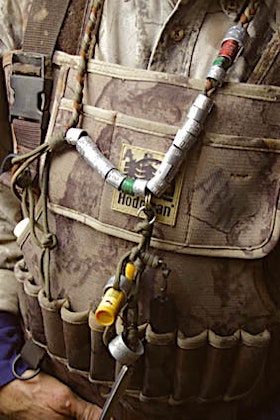For waterfowl hunters, duck and goose bands are among the most treasured mementos of the hunt. Killing a banded bird is a special thrill. Wearing a lanyard of bands around your neck is a symbol of status.
The value and importance of waterfowl bands far exceeds that of mere jewelry, however. Hunters who report their bands play a vital role in waterfowl conservation. The reports not only provide interesting insight into the lives of waterfowl, but also hopefully foster a much greater appreciation for our quarry.
Duck Banding
From 1914 through 2007, about 13 million ducks had been banded in North America. The mallard leads the flock, with about 7 million banded. Blue-winged teal are a distant second at more than 1.5 million, followed by pintails and wood ducks (1.3 million), black ducks (1 million) and green-winged teal (500,000).
Not surprisingly, the duck bands most often found on hunters’ lanyards are those found on commonly banded species such as mallards (around 1 million recoveries), black ducks (160,000), pintails (147,000) and wood ducks (140,000). Among the real rarities are the 2,000 or so bands (per species) recovered from cinnamon teal, common goldeneyes and buffleheads. Rarer still are bands from ruddy ducks, long-tailed ducks (oldsquaws) and spectacled eiders. If you have a ruddy duck band, you’re one of only 550 hunters who can make that claim. Only 61 long-tailed duck bands have been recovered, and only 10 spectacled eider bands!
Goose Banding
Canadas are banded far more often than other goose species, with more than 2.8 million banded since 1914. Snow geese rank second at approximately 750,000, followed by white-fronted geese (specklebellies;122,000), black brants (107,000), Ross’s geese (76,000) and Atlantic brants (31,000).
More than 715,000 Canada goose bands have been recovered, 118,000 snow goose bands and 22,000 white-fronted goose bands. Among the real rarities are the 145 bands recovered from 9,500 banded emperor geese. Rarer still are bands from barnacle geese and Hawaiian geese. Should you have a barnacle goose band, it’s one of only nine ever recovered (only 11 barnacle geese have been banded). And only four Hawaiian goose bands have been recovered from the 700-plus birds that have been banded.
Unlikely Landing Spots for Duck Bands

Glad To Be There
Ducks Unlimited biologist Mike Checkett was hunting on the Missouri River in 2003 when one of his hunting partners shot a Canada goose Checkett had banded in 1997.
Gator Food
A band placed on the leg of a pintail in Canada’s Northwest Territories was recovered from the stomach of an American alligator in Florida’s Orange Lake 13 months later.
Against All Odds
Dr. Stan Chace of Alturas, Calif., seemingly defied all odds in the fall of 1962. Chace bagged a banded Canada goose in October, and shot another banded Canada in December. When he compared the bands, Chace found them to be consecutively numbered — the first 518-31661 and the second 518-31662. The birds were banded three years earlier.
Duck Dogs
In the 1950s, biologists used retrievers to catch young mallards for banding on the nesting grounds in Canada.
Feeling Trapped
One black duck drake was captured 18 times during a nine-year span in Michigan Department of Conservation banding traps. An adult when first trapped and banded in 1949, the duck successfully eluded hunters and wildlife predators for 10 years. Caught in a trap on January 31, 1958, the bird’s original leg band, which was worn thin with age, was replaced.
Marathon Flyer Enjoys Travel
A pintail banded on September 2, 1940, in Athabasca County of northern Alberta eluded hazards until January 1954 when it was shot near Naucuspana, Mexico. Considering the 3,000 miles between band site and death, and assuming the bird made the two-way migration each year for 13 years, the pintail would have logged nearly 80,000 migration miles during its lifetime.
Hitting The Jackpot
Acquiring one bird band a season is great. But how about two, on consecutive shots, on the same day? That’s what happened to Howard Ewart on November 23, 1996, when he shot a pair of banded mallard drakes while hunting on Wyoming’s Big Horn River. Also living a charmed existence was Jack Needles, who, on December 24, 1992, bagged a banded black duck drake and a banded mallard hen in New Jersey. The birds arrived as a pair.
Age Records
Information on life span is collected every time a banded bird is reported to the Bird Banding Laboratory in Laurel, Maryland. And the record ages for some waterfowl species might surprise you.
• Canada goose, 33 years, 3 months
• Canvasback, 29 years, 6 months
• Lesser snow goose, 27 years, 6 months
• Black duck, 26 years, 5 months
• Mallard 26 years, 4 months
• Greater white-fronted goose, 23 years, 6 months
• Blue-winged teal, 23 years, 3 months
• Redhead, 22 years, 7 months
• Ross’s goose, 22 years, 6 months
• Wood duck, 22 years, 6 months






